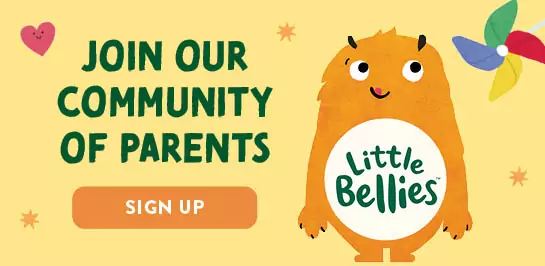Play with Food Guide: Tips, Hacks and Game Ideas
Reading time:
Reading time:

Playing with food plays a very important role in child development. By playing with their food, children learn about the world and develop a positive association with a variety of foods. It engages their senses and stimulates their curiosity. They can squish, squeeze, and mold food, helping to develop their fine motor skills and hand-to-eye coordination.
Playing with food also encourages creativity and imagination: children can use food to build structures, create artwork, and role-play imaginative scenarios. This supports their cognitive development and helps them learn problem-solving skills.
Playing with food is also a valuable social experience. When children play with their food together, it promotes cooperation, communication, and sharing.
Below is a play-with-food guide with many great hacks and games we’ve developed for you in collaboration with Simone Emery, Pediatric OT and Nutritionist.
Children become familiar with food through what they see. They love watching you eat. They love seeing what is happening in their world. Seeing food in their environment is their first food experience and it starts well before we start them on solids. As children grow older, they become more curious about the world around them. Having food as a consistent, but not pressurised, part of their world lets them see what food is about.
Try these ideas to expand what your child sees in their world of food:
Food is about nutrition, yet there are social and motor skills to learn in the context of eating. Children absorb so much of what to do with food from the context it is served. Mealtimes with a few food groups show children that variety is normal and that we eat from a range of food groups at the same time. All meals, including morning and afternoon snack time, are a chance to present a few food groups alongside each other.
At morning snack, you can enhance the contexts your child is building around food. Instead of only offering fruit, vegetables, or grains, aim to serve something from a few food groups. For example, cubes of zucchini egg frittata with diced peaches and Little Bellies whole grain snacks for babies give your child the opportunity to see 4 food groups in one snack opportunity. Variety is our long-term objective.
Your child can learn so much from pressure-free playful interactions with food. Play is effective and serious research for them! During play, children are learning about textures, temperatures, colors, sounds, smells and flavors. Helping them label the sensory aspects of foods builds their receptive language (the words that they hear and understand) around food. When they are ready, they will have the words to say things like “this is juicy” instead of “nice”, “yuck” or other ambiguous phrases. Expressive language is such a wonderful foundation to give your child and it starts with learning via the words you use. More on the role of playing with food in Simone’s article Why is Playing with Food Important?
We have a host of Little Bellies games designed to get little fingers playing! When possible, include some new food groups in your play. For example, team up with the Little Bellies softcorn round-a-bouts to make a flower with some blueberries, strawberries and cucumber. This simple flowery creation has 4 food groups! Your creations don’t have to be perfect or hard to prepare. In fact, they should be simple, interactive and messy! The value for your child is in the process, not the product.
Game Concept: To lick and join 3 Little Bellies fiddlesticks end to end. Hold them up to see how steady your fiddlestick tower is.
Purpose: A lick of new food is a great way to introduce new flavors to children. It sometimes takes a range of exposures like licks for new foods to become accepted foods for some children. This game encourages them to lick the end of the stick in order to stick them together. Once you stick two together, the motor planning challenge to stick three together is much greater and suited to 18+ months (yet younger children may like to help you make stick towers). Once three sticks are stuck together, see if you can hold your tower upright without it falling over.
Kids love constructing and deconstructing. Making a stick tower encourages children to have a taste of these tomato multigrain sticks in a very CONSTRUCTIVE way.
Game Concept: To slowly bowl a fresh blueberry towards a Little Bellies blueberry puff wielding batter hoping to get through to the catcher (cup) while the batsman aims to divert the blueberry away from the cup.
Purpose: A fun activity designed to improve pincer grip with repeated picking up of the blueberries and puffs. Improved spatial awareness by maneuvering the cup, blueberries and puff. This also aims to build exposure to fruits and flavored dissolvable puff. Blueberries and Little Bellies blueberry puffs are easy to chew for our little learners and they are ready to swallow in 2 or so chews.
Modelling having fun and enjoying foods with different functional properties helps children feel relaxed about new foods. The movement concepts of rolling, batting and catching are found in this simple game. Play is learning!
Game Concept: Just like a traditional egg and spoon race, animal crackers take on the role of the humble egg. The objective of the game is to get from one side of the room to the other whilst balancing an animal cracker in a spoon at the end of an outstretched arm. You can use a variety of spoons to change up the feeling of the animal crackers being balanced across the room. Will the butterfly wing its way to victory ahead of the sheep?
Purpose: To improve hand-eye coordination and feel the sensation of different crackers in different spoons. This will work towards improved cutlery usage.
Game Concept: Using peeled ribbons of raw carrot as garments, twist, bend, wrap and decorate your Little Bellies animal-shaped cracker in creative outfits. This incorporates vegetables into food play with fun animal shapes.
Purpose: To improve fine motor skills and creative expression. Ribbons of carrots and Little Bellies crackers are both mechanical foods that require a similar level of oral motor skills to eat. You can also use some cream cheese to help stick the costume onto the cracker.
Game Concept: To stand the pick-me sticks upright in a dollop of mashed sweet potato or potato.
Purpose: This is a motor planning challenge for little fingers and hands. In this game, you are helping your baby’s little fingers learn the weight sensation of the pick-me stick. Learning to feel the sensation of different weights in little hands prepares your baby for self-feeding tasks.
Game Concept: Use the sweetcorn round-a-bouts as a pretend bus that goes for a bumpy ride up your child’s arm and to the top of their nose.
Purpose: To learn about a new food shape and taste with a familiar concept of a bus.
Game Concept: To blow a softcorn across a baking tray using big breaths. The race can start on the count of three and finish when the softcorn hits the other side of the baking tray. To extend this game, you and your child can race your own softcorns across the baking tray.
Purpose: This game aims to encourage deep breaths, and oral motor planning skills and to learn about movement concepts.
Racing softcorn is simple to set up with age-appropriate learning outcomes and physical skill building.
Have fun and bon appétit!
Photo by Juan Encalada on Unsplash

Get the latest news on parenting tips, food play hacks, promotions and giveaways!
Subscribe Now